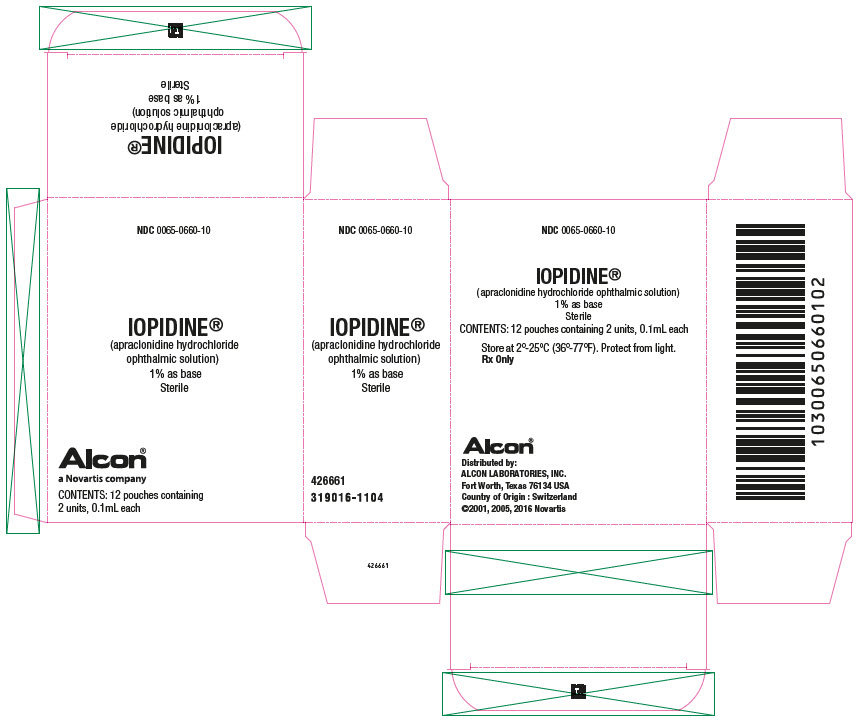Iopidine
Generic name: apraclonidine ophthalmic
Drug class: Ophthalmic glaucoma agents
Medically reviewed by A Ras MD.
What is Iopidine used for?
Iopidine is a prescription medicine that is used to lower high eye pressure.
Description
IOPIDINE 1% Ophthalmic Solution contains apraclonidine hydrochloride, an alpha adrenergic agonist, in a sterile isotonic solution for topical application to the eye. Apraclonidine hydrochloride is a white to off-white powder and is highly soluble in water. Its chemical name is 2-[(4-amino-2,6 dichlorophenyl)imino] imidazolidine monohydrochloride with an empirical formula of C9H11Cl3N4 and a molecular weight of 281.6.
The chemical structure of apraclonidine hydrochloride is:

Each mL of IOPIDINE 1% Ophthalmic Solution contains: Actives: apraclonidine hydrochloride 11.5 mg equivalent to apraclonidine base 10 mg. Inactives: sodium chloride, sodium acetate, sodium hydroxide and/or hydrochloric acid (pH 4.4-7.8), purified water and benzalkonium chloride 0.01% (preservative). Osmolality is 260-320 mOsm.
Before taking Iopidine, tell your doctor:
- If you are allergic to Iopidine; any part of this medicine; or any other drugs, foods, or substances. Tell your doctor about the allergy and what signs you had.
- If you are taking certain drugs used for depression like isocarboxazid, phenelzine, or tranylcypromine, or drugs used for Parkinson’s disease like selegiline or rasagiline.
This is not a list of all drugs or health problems that interact with this medicine.
Tell your doctor and pharmacist about all of your drugs (prescription or OTC, natural products, vitamins) and health problems. You must check to make sure that it is safe for you to take Iopidine with all of your drugs and health problems. Do not start, stop, or change the dose of any drug without checking with your doctor.
What are some things I need to know or do while I take Iopidine?
- Tell all of your health care providers that you take Iopidine. This includes your doctors, nurses, pharmacists, and dentists.
- Avoid driving and doing other tasks or actions that call for you to be alert or have clear eyesight until you see how Iopidine affects you.
- Do not use longer than you have been told by the doctor.
- Have your eye pressure and eyesight checked as you have been told by the doctor.
- Talk with your doctor before you drink alcohol or use other drugs and natural products that slow your actions.
- Tell your doctor if you are pregnant, plan on getting pregnant, or are breast-feeding. You will need to talk about the benefits and risks to you and the baby.
How is Iopidine best taken?
Use Iopidine as ordered by your doctor. Read all information given to you. Follow all instructions closely.
- For the eye only.
- Take out contact lenses before using Iopidine. Lenses may be put back in 15 minutes after Iopidine is given. Do not put contacts back in if your eyes are irritated or infected.
- Do not touch the container tip to the eye, lid, or other skin.
- Tilt your head back and drop drug into the eye.
- After use, keep your eyes closed. Put pressure on the inside corner of the eye. Do this for 1 to 2 minutes. This keeps the drug in your eye.
- If more than 1 drug is being used in the same eye, use each drug at least 5 minutes apart.
What do I do if I miss a dose?
- Use a missed dose as soon as you think about it.
- If it is close to the time for your next dose, skip the missed dose and go back to your normal time.
- Do not use 2 doses at the same time or extra doses.
What are the side effects of Iopidine that I need to call my doctor about immediately?
WARNING/CAUTION: Even though it may be rare, some people may have very bad and sometimes deadly side effects when taking a drug. Tell your doctor or get medical help right away if you have any of the following signs or symptoms that may be related to a very bad side effect:
- Signs of an allergic reaction, like rash; hives; itching; red, swollen, blistered, or peeling skin with or without fever; wheezing; tightness in the chest or throat; trouble breathing, swallowing, or talking; unusual hoarseness; or swelling of the mouth, face, lips, tongue, or throat.
- Change in eyesight, eye pain, or very bad eye irritation.
- Eyelid swelling.
- Eye discharge.
- Feeling that something is in the eye.
What are some other side effects of Iopidine?
All drugs may cause side effects. However, many people have no side effects or only have minor side effects. Call your doctor or get medical help if any of these side effects or any other side effects bother you or do not go away:
- Blurred eyesight.
- Eye irritation.
- Dry eyes.
- Dry mouth.
- More tears.
- Dizziness.
- Feeling sleepy.
These are not all of the side effects that may occur. If you have questions about side effects, call your doctor. Call your doctor for medical advice about side effects.
You may report side effects to the FDA at 1-800-332-1088. You may also report side effects at https://www.fda.gov/medwatch.
If overdose is suspected:
If you think there has been an overdose, call your poison control center or get medical care right away. Be ready to tell or show what was taken, how much, and when it happened.
How do I store and/or throw out Iopidine?
- Store at room temperature. Do not freeze.
- Protect from light.
- Keep all drugs in a safe place. Keep all drugs out of the reach of children and pets.
- Throw away unused or expired drugs. Do not flush down a toilet or pour down a drain unless you are told to do so. Check with your pharmacist if you have questions about the best way to throw out drugs. There may be drug take-back programs in your area.
Label
PRINCIPAL DISPLAY PANEL
- NDC 0065-0660-10IOPIDINE®
(apraclonide hydrochloride ophthalmic solution) 1% as base
SterileAlcon®
a Novartis company
CONTENTS: 12 pouches containing
2 units, 0.1mL each

SRC: NLM .
